Journal of Medical & Surgical Pathology
Open Access
ISSN: 2472-4971
ISSN: 2472-4971
Case Report - (2022)Volume 7, Issue 3
Background: Compartment syndrome is a medical-surgical emergency. In fact, it is a "race against the clock" to reduce, as quickly as possible, the pressure inside a well-defined muscular compartment. Its development at the hand level as part of a crushing trauma is a rare localization and mainly affects the radial interosseous muscular compartment. The diagnosis of hand compartment syndrome is primarily clinical. Its classical clinical triad includes spontaneous pain, paralysis, and pain increase during passive extension. Any additional examination must not, in any sense, delay the patient's management. Ignoring this surgical emergency can cause permanent damage to the hand.
Case presentation: In this article, we will discuss our experience with two cases who presented with hand compartment syndrome after suffering numerous metacarpal fractures as a result of trauma. The treatment included a discharge dermofasciotomy, metacarpal pinning, and close hand surveillance. Excellent outcomes were seen after three months, with complete functional recovery of hand mobility.
Conclusion: The compartment syndrome in the hand is a rare localization that affects the hand's functional prognosis. Its treatment consists of two key components: discharge aponeurotomy and bone stabilization. There should be no delay in surgical treatment for this syndrome.
Compartment syndrome; Metacarpal fractures; Hand; Discharge incisions
M2: Second Metacarpal; M3: Third Metacarpal; M4: Fourth Metacarpal; M5: Fifth Metacarpal
Acute limb compartment syndrome is a medical and surgical emergency defined by a series of symptoms that occur after pressure builds up in a muscle compartment. It is a conflict that does not resolve itself spontaneously between a spreading content and a container that is not easily extensible. It is a condition that, if left untreated or treated late, has severe functional consequences, including amputation. The vital prognosis may be jeopardized in some cases, particularly those involving crushed limbs. Hand localization compartment syndrome is a rare but frightening condition, even when associated with a crush. This is explained by the hand's anatomical peculiarity, which is responsible for a significant difference in pressure between the compartments, thus the risk of its ignorance.
A 31-year-old right-handed day laborer who suffered a crash trauma to his right hand as a result of a public road accident (a motorcycle being hit by a car), resulting in pain and total functional impotence. The patient presented with an oedematous hand in a discrete intrinsic position as well as skin elasticity loss (Figure 1). The diagnosis of compartment syndrome was based on a triad: spontaneous pain that increased during passive extension, intolerability, and resistance to painkillers, allowing us to distinguish it from other common fracture pains. A simple palpation of the increased- volume muscular masses accentuates this pain. The appearance of neurological symptoms such as paresthesia in the pulp of the first three fingers indicates median nerve compression at the wrist. The radiological examination (Figure 2) revealed multiple fractures of the right hand's metacarpals (M2-M3-M4-M5), with no associated dislocation or foreign body. The hand compartment syndrome was retained when these symptoms appeared.
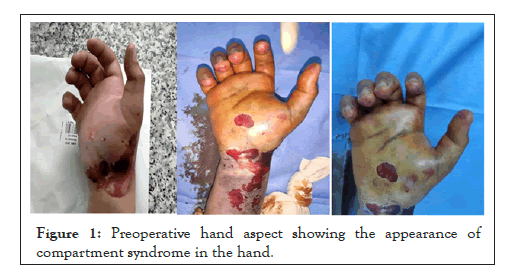
Figure 1: Preoperative hand aspect showing the appearance of compartment syndrome in the hand.
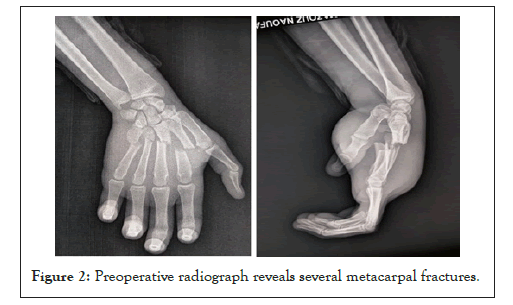
Figure 2: Preoperative radiograph reveals several metacarpal fractures.
The patient underwent emergency surgery while under general anesthesia, supine, with his hands on a hand-table, and under radioscopic control. After reduction with external maneuvers, metacarpal fractures are stabilized with intramedullary pinning (Figure 3). M2 and M3 pins, which are fixed metacarpals, do not tolerate rotational deformity and thus provide good stability. To treat the compartment syndrome, which is the only way to reduce pressure inside a compartment? To avoid damaging the median nerve by evacuation of the hematoma, we made two dorsal incisions (radial edge of M2 and M4) and an incision next to the carpal canal by a section of the carpal anterior annular ligament (Figure 4). Finger splints were worn to keep the injured fingers in place while they healed. While the hand was slightly raised, a check x-ray was performed (Figure 5). In 48 hours, the pain had completely subsided. Paresthesia gradually faded over the course of 72 hours. The skin seal was performed without tension on the seventh day. On the eighth day, the patient was released. The patient was seen on a regular basis. The pins were removed under local anesthesia in the sixth week. In the second month, the patient was able to return to work. At his most recent clinical and radiological check-up in the sixth month, he reported no discomfort with his hand (Figure 6).
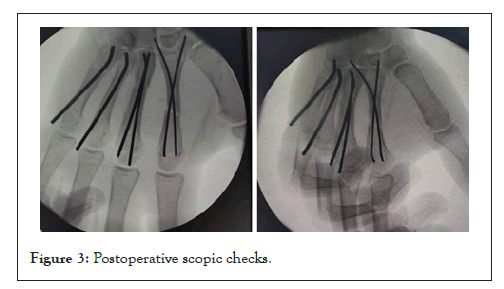
Figure 3: Postoperative scopic checks.
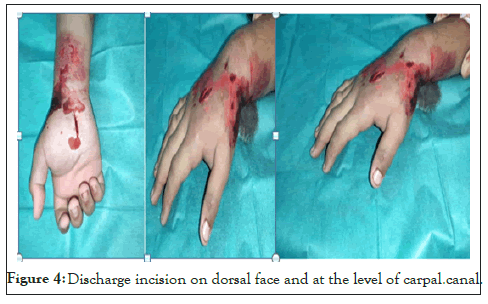
Figure 4: Discharge incision on dorsal face and at the level of carpal canal.
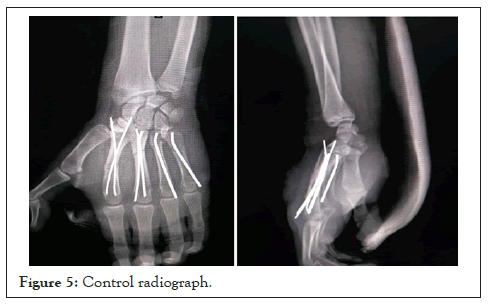
Figure 5: Control radiograph.
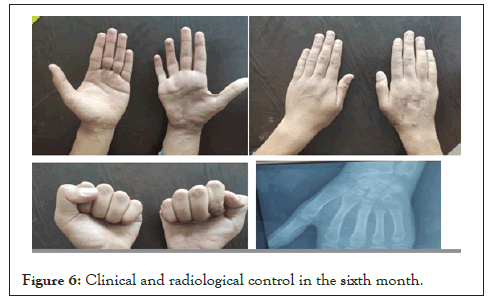
Figure 6: Clinical and radiological control in the sixth month.
A 25-year-old right-handed taxi driver with no significant pathological history was involved in a traffic accident that caused trauma to his left hand. We found a very oedematous left hand with two superficial wounds on the dorsal side of the ulnar edge of the hand during the clinical examination. The vascular examination revealed no abnormalities. The palpation was very painful, and even the slightest movement exacerbated the pain. A transverse fracture of the second and third displaced fingers was discovered using standard radiography. We performed emergency surgery on the patient, making a discharge incision in the second interdigital space and intramedullary pinning of the second and third metacarpals. The postoperative follow-ups were favorable, with a significant improvement in pain and the complete absence of tingling. After 48 hours, the patient was declared discharged. The clinical course was favorable, with hand functions recovered after 5 months (Figure 7).
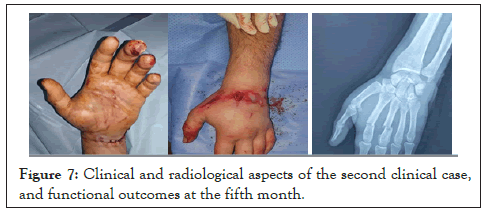
Figure 7: Clinical and radiological aspects of the second clinical case, and functional outcomes at the fifth month.
The muscular layers at the limb level are organized in muscular compartments, and their organization varies depending on anatomical location. There are results of three muscular compartments at the level of the hand (thenar, hypothenar, and interosseous). The interosseous muscles are the most likely to be cramped in their compartments. Indeed, only the first three dorsal interosseous muscles are completely covered by a solid fascia, as Kumar [1] demonstrated in their anatomical study of corpses. Fascia covers the thenar muscles intermittently, and soft tissue covers the hypothenar muscles. This could explain the low incidence of hand compartment syndrome. According to Spinner et al. [2], the diagnosis of compartment syndrome was based on a triad of symptoms: spontaneous pain, paralysis, and increased pain during passive extension or stretching. The emergence of intolerable pain that develops resistance to painkillers is extremely evocative [3]. The pain is exacerbated by simple palpation of the enlarged muscular masses. However, because of associated fractures, this pain must be relativized in some cases [4]. In a study, Gong and Lu [5] found seven cases of compartment syndrome out of 382 multiple metacarpal fractures, a rate of 1.8 percent. Other studies found more atypical compartment syndrome caused by insect stings [6] and heroin injection [7]. An intramuscular pressure measurement allows us to define compartment syndrome objectively. Gong and Lu [5] suggest that a pressure greater than 40 mmHg must result in fasciotomy even in the absence of clinical signs. However, the normal value of this pressure, as well as the critical level above which surgical release is required, are still debatable. According to Matsen et al. [8], the concept of critical pressure is of limited utility. We believe that measuring intramuscular pressure should not delay patient management; it is principally used in rare cases. Although even the slightest suspicion of a compartment syndrome must result in discharge incisions, the phenomenon is irreversible once initiated: it is then a "race against the clock" to break the vicious circle (case 2). The aponeurotomy should be performed within the first 6 hours to avoid aggravating the clinical presentation, which can lead to a complete and permanent loss of hand function due to retraction of intrinsic muscles, known as Finochietto's syndrome [9]. Spinner highlighted the importance of early diagnosis in a series of 14 cases [2]. We performed neurolysis of the median nerve by section of the anterior ring ligament of the carp, as recommended by Ouellette and Kelly, due to the presence of paresthesia in the pulp of the first three fingers caused by compression of the median nerve to the wrist [10]. Other teams, such as Gong and Lu [5], never performed it, even if there were paresthesias of the median nerve, and observed a three-month recovery of the median nerve. We recommend leaving the discharge incisions open or bringing the edges together with two simple points. Plate osteosynthesis was not possible. In this situation, we have not found a preferred technique in the literature.
Hand compartment syndrome is a rare condition that necessitates quick and effective surgical intervention. Once the phenomenon has begun, it is irreversible. Only the discharge incisions have the potential to break the vicious circle. This is explained by the hand's anatomical peculiarity, which is responsible for a significant difference in pressure between the compartments, thus the risk of its ignorance. In this article, we describe a compartment syndrome in the hand as part of a crushing trauma with multiple metacarpal fractures in two clinical cases. In this article, we describe a compartment syndrome in the hand as part of a crushing trauma with multiple metacarpal fractures in two clinical cases.
I agree with the above statements and declare that this submission follows the policies of Solid State Ionics as outlined in the Guide for Authors and in the Ethical Statement. And the paper is not currently being considered for publication elsewhere. The paper reflects the authors' own research and analysis in a truthful and complete manner. The paper properly credits the meaningful contributions of co-authors and co-researchers. The results are appropriately placed in the context of prior and existing research.
Written informed consent was obtained from the patient for publication of this case report and accompanying images. A copy of the written consent is available for review by the Editor-in-Chief of this journal on request.
1. We declare that this manuscript is original, has not been published before and is not currently being considered for publication elsewhere.
2. We confirm that the manuscript has been read and approved by all named authors and that there are no other persons who satisfied the criteria for authorship but are not listed.
3. We further confirm that the order of authors listed in the manuscript has been approved by all of us.
4. We understand that the Corresponding Author is the sole contact for the Editorial process.
5. He is responsible for communicating with the other authors about progress, submissions of revisions and final approval of proofs.
Not applicable
The authors have declared no conflicts of interest. The authors declare that they have no known competing financial interests or personal relationships that could have appeared to influence the work reported in this paper.
We have not received any funding for this article.
All authors contributed to the conduct of this research and read and approved the final version of the manuscript. Written informed consent was obtained from the patient to publish this report in accordance with the journal's patient consent policy" on the title page of the manuscript.
We thank our colleagues who provided insight and expertise that greatly assisted the research, although they may not agree with all of the interpretations of this paper.
[Crossref][Google Scholar][PubMed].
[Crossref][Google Scholar][PubMed].
[Crossref][Google Scholar][PubMed].
[Google Scholar][PubMed].
[Crossref][Google Scholar][PubMed].
[Google Scholar][PubMed].
[Google Scholar][PubMed].
[Crossref][Google Scholar][PubMed].
Citation: Bouziane W, Karbal J, Agoumi O, Daoudi A (2022) Compartment Syndrome of the Hand: A Rare Localization with a Poor Prognosis: Two Case Reports and a Literature Review. J Med Surg Pathol. 7:246.
Received: 08-Aug-2022, Manuscript No. JMSP-22-18849; Editor assigned: 11-Aug-2022, Pre QC No. JMSP-22-18849 (PQ); Reviewed: 26-Aug-2022, QC No. JMSP-22-18849; Revised: 02-Sep-2022, Manuscript No. JMSP-22-18849 (R); Published: 09-Sep-2022 , DOI: 10.35248/2472-4971.22.07.246
Copyright: © 2022 Bouziane W, et al. This is an open-access article distributed under the terms of the Creative Commons Attribution License, which permits unrestricted use, distribution, and reproduction in any medium, provided the original author and source are credited.